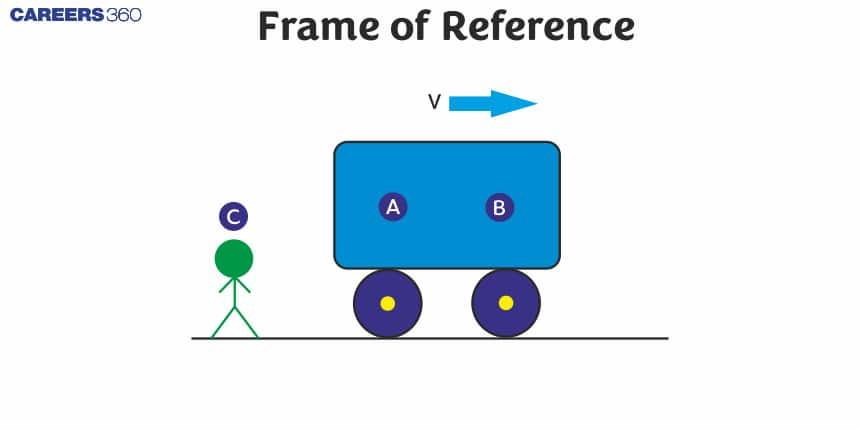Frame of Reference - Definition, Types, Example, Difference, FAQs
Have you ever experienced that when the elevator moves upward or downward you feel heavier or lighter? This is because of the observing motion in different Frame of reference. A frame of reference is a system that lets you measure and represent the motion or position in terms of some known coordinate. In this article, we will explore this concept in detail with their types and respective examples.
This Story also Contains
- What Is Reference?
- What is Frame of Reference?
- Example of Frame of Reference
- Types of Frame of Reference
- Difference between Inertial and Non-inertial frame of reference

What Is Reference?
In Physics, reference meaning is a relationship between objects during which one object designates, or acts as a way by which to attach to or link to, another object. The reference name meaning in Hindi is “संदर्भ”.
What is Frame of Reference?
The meaning of Frame of reference is “A system of geometric axes in relation to which measurements of size, position, or motion can be made”. The meaning of frame of reference in hindi is “संदर्भ विन्यास”.
Definition of Frame of Reference
A frame of reference is a set of coordinates that can be used to find out positions and velocities of objects in that frame. Different frames of reference can move relative to one another
A frame of reference (or reference frame) consists of an abstract coordinate system whose origin, direction, and scale are identified by a set of reference points.
Reference point- Geometric point whose position is specified both mathematically and physically.
Also read -
Example of Frame of Reference
If you throw and catch a ball while on a train moving at a constant velocity relative to a station, the motion of the ball appears different to observers in two different frames of reference:
Observer on the Train:
To the person on the train, for example, the ball seems to go up and then down under the effect of gravity. Even in this case, the observer does not see the train moving since he himself is in the same frame as the ball.
Observer at the Station:
For the person standing on the station platform, the ball will seem to be moving in a parabolic trajectory. This is because the horizontal velocity of a ball is equivalent to the speed of the train in addition to its vertical motion due to gravity.

All problems in physics can be analysed in any frame of reference (i.e. coordinate system) provided that frame transformations are properly used.
|
Related Topics |
Types of Frame of Reference
There are two types of Frame of reference:
- Inertial frame of reference
- Non-inertial frame of reference
Inertial Frame of Reference:
Before moving to Inertial frame of reference let's discuss Inertia in brief:
Inertia is that the property of a body by the virtue of which it either remains at rest or within the state of motion until it's acted upon by any external force.
What is Inertial Frame of Reference?
"A frame of reference that remains at rest or passes with constant velocity with respect to other frames of reference is called Inertial Frame of Reference."
Inertial frames of reference possess a constant velocity. That it is passing at a constant speed in a straight line. Newton’s laws of motion are reasonable in all inertial frames of reference. Here, a body does not swap because of external forces. All inertial frames of reference are identical for the measurement of physical occurrence.
Example of Inertial Frame of Reference:
- A train moving at a constant velocity in a straight line is an example of inertial frame of reference.
- If you throw a ball straight up while sitting in the train, it will appear to move vertically up and down relative to you, following Newton's laws.
Non-Inertial Frame of Reference:
"A non-inertial frame of reference is one which is accelerating or rotating in some respect. Things move or behave differently in such frames because the frame itself is moving. We use imaginary forces, called pseudo forces, to explain this behavior."
In a non-inertial frame of reference, Newton’s laws of motion are not valid. As well, it does not have a constant velocity and is accelerating.
Example of Non-Inertial Frame of Reference:
- If you were in a car turning sharply, you feel like being pushed outward. But there’s no actually force pushing you outwards. It’s a non-inertial frame caused because of the car’s acceleration
- If you're on a spinning merry-go-round you feel like you're going out. The 'force' that is thrust outward is a pseudo force caused by this merry-go-round's rotation.
Difference between Inertial and Non-inertial frame of reference
|
Inertial frame of reference
|
Non-inertial frame of reference
|
| The body passes with a constant velocity (can be zero). | The body passes with varying velocity. |
| Newton’s laws are complied. | Newton’s law is not complied. |
| The body does not facilitate/accelerate | The body undergoes facilitate/accelerate |
| In this frame, the force acting on the body is real speed/ force. | The acceleration of the frame gives rise to a pseudo speed/force. |
| Example: a rocket in inter-galactic space (gravity-free space between galaxies) with its entire engine shut. | Example: if a just starts its motion from rest, then during the time of acceleration the car are going to be during a non-inertial frame of reference. |
Frequently Asked Questions (FAQs)
Velocity may be a vector quantity which has both magnitude and direction whereas speed may be a scalar quantity which has only the magnitude. to place this in simple terms, velocity is the speed at which an object moves during a particular direction, like the speed of a motorcycle traveling north on a serious freeway, or the speed a rocket moves because it launches into space. The displacement of an object during a specific amount of your time means velocity which velocity has units of distance divided by time, like miles per hour or kilometers per hour or meters per second. The dimension of velocity represented by L T-1. The change in position divided by the time of travel is claimed to be average velocity.
v = d / t
Where, v = velocity
t = time taken by the thing.
Velocity measures the motion of an object that starts passing from one place and starts heading towards another place. Once we put it another way, you employ measures of velocity to make a decision how quickly you or any object in motion will reach a destination from a given location.
Measures of velocity provide you to make timetables for travel and plan your schedule accordingly. For eg., if a train leaves ABC Station in Bangalore at 6 p.m. and you allow the speed at which the train is moving the opposite station, you'll predict when it'll reach the destination station.
Earth may be a non-inertial coordinate system.
Explanation: By now, we are conscious of the very fact that a coordinate system frame of reference may be a reference frame where an object is either moving with a continuing velocity or at rest. In such a frame, there's no net force working on an object as a result the thing isn't accelerated. However, during a non-inertial coordinate system, the motion of an object is acted upon by fictitious forces and other forces thanks to external action.
Earth rotating about its own axis causes an external force that leads to the acceleration of the motion of objects. This means that the world isn't an inertial coordinate system.
Relative motion is simply a sort of saying that sometimes various people will say distinctive things about the motion of an equivalent object. This is often not because one is wrong, but because they're using distinctive frames of reference.
The best thanks to understanding this is often possible to see in some cases.
In the entire subsequent instance, neglect air resistance.
Relative velocity, within the above cases, everyone was determining the speed of the oranges relative to which is compared to the frame of reference that you simply are standing in. Relative to an individual standing on the footpath, the orange could also be moving at 8 m/s, while for an individual within the frame of reference of the truck, the orange is moving at 12 m/s relative to the person.